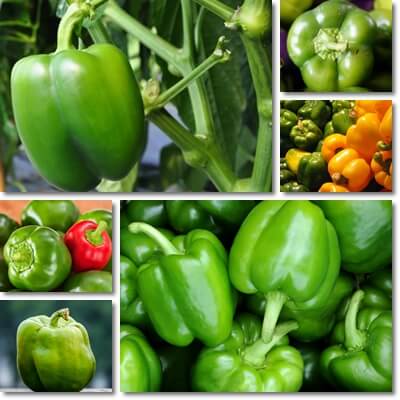Green bell peppers are a cultivated variety of Capsicum annuum. The peppers of this particular cultivar are harvested while still unripe, before they develop pigment. Which means green bell peppers aren’t ripe. Despite this, they are a good source of nutrition, providing important amounts of vitamins B3 and B6 as well as vitamins C and K, not to mention antioxidant chlorophyll, beta-carotene, lutein and zeaxanthin, dietary fiber, potassium, manganese and other vitamins and minerals.
Green bell peppers thus hold benefits for the immune system, skin health and diabetes, and are a good food to eat for healthy weight loss, constipation relief, high blood pressure and high LDL cholesterol.
Are green bell peppers unripe?
As indicated by their color, green bell peppers aren’t ripe – they are picked before they ripen completely so they don’t develop any pigment and stay green. If left long enough on the plant, the fruits will eventually ripen and change color. The change in pigment from green to red or some other color is a sign the fruits are ripening.
To share my personal experience, this year, my red bell pepper plants produced fruits that went from green straight to red and from green straight to black (and no, it was not sunscald). Having two different-colored peppers on the same plant was curious, but also a pleasant surprise as I did not know it was even possible.
Find out more about the properties and benefits of black bell peppers.

When are green bell peppers fully ripe?
When they turn completely red, yellow, orange, pale green or ‘white’, purple or black, depending on the cultivar. Different cultivars will produce fruits that ripen to different colors. Sometimes, the fruits will change color several times before becoming completely ripe, such as from green to orange and then to red; or from green to red to purple and then black; or from green to black then finally to red. And sometimes they will only go from green to just one other color, whether red or purple or black or something else.
The final pigment is usually determined by the choice of cultivar, although sometimes nature can take things into her own hands and surprise you.
What does a green bell pepper look like?
As its name suggests, the green bell pepper is shaped somewhat like a bell. It is medium to large in size, depending on growing conditions, blockish-looking and hollow inside. The fruit has smooth, shiny skin and thick flesh, and is visibly segmented, with 3 to 4 lobes at the base. Both the skin and the flesh are the same color: a deep, medium green. The skin is smooth, shiny, almost waxy-looking and extremely thin. The flesh is thick, meaty and crisp, but bitter-tasting. Inside, at the base of the stem, there is a green and white spongy pulp to which dozens of tiny, round, flat, creamy-white seeds are attached. If you collect and plant the seeds, you can grow your own bell pepper plant, even though the fruit is technically not yet fully ripe. While not all the seeds will germinate, if the fruit is mature enough, a lot of them will.
Are green bell peppers sweet peppers?
Despite the fact they taste bitter because they’re unripe, green bell peppers are technically a variety of sweet pepper. The name may seem confusing because they’re not actually sweet, but that’s just because they’re harvested prematurely – if they get to ripen, they will become sweeter-tasting. The term ‘sweet’ is used here as an antonym to ‘spicy’, to differentiate non-pungent varieties from pungent ones, which would mean that sweet peppers refers to non-spicy varieties.

What does a green bell pepper taste like?
Given that green bell peppers aren’t ripe, they will taste bitter, some more than others, with a strong non-pungent pepper flavor profile. I find their flavor is considerably stronger than that of other colors. Bitterness intensity will differ depending on when exactly the fruits have been harvested. But the flesh is thick, meaty and crisp which adds to the appeal of the unripe fruit.
If you are wondering what to do with bitter-tasting green bell peppers, then know their uses are the same as those of other colors. They can be eaten raw in salads or dipped in cream cheese, hummus, a fried bean dip. They are great roasted, peeled and dipped in a crushed garlic, salt and water sauce. One of the recipes I find best showcases their flavors is finely sliced, stir-fried green bell pepper spaghetti with oregano, olive oil and grated Parmesan. Fried green bell pepper white rice risotto is the most delicious pair of flavors. For those of you who are not very fond of bitter vegetables, try stuffing them with rice, ground meat and tomato sauce, ground meat and cheese or even rice and raisins or dried plums.
Green bell pepper nutrition facts per 100 g
- Energetic value: 20 kilocalories/kcal
- Fat: 0.17 g
- Protein: 0.86 g
- Carbohydrates: 4.64 g
- Sugars: 2.4 g
- Dietary fiber: 1.7 g
- Vitamins in green bell peppers:
- Vitamin A: 18 micrograms/mcg RAE (retinol activity equivalent) from carotenoid antioxidants with vitamin A activity (beta-carotene, alpha-carotene, beta-Cryptoxanthin)
- Vitamin B1: 0.057 mg
- Vitamin B2: 0.028 mg
- Vitamin B3: 0.48 mg
- Vitamin B5: 0.099 mg
- Vitamin B6: 0.224 mg
- Choline (vitamin B7, B8 or H): 5.5 mg
- Vitamin B9: 10 micrograms/mcg
- Vitamin B12: 0 micrograms/mcg
- Vitamin C: 80.4 mg
- Vitamin D: 0 micrograms/mcg
- Vitamin E: 0.37 mg
- Vitamin K: 7.4 micrograms/mcg
- Minerals in green bell peppers:
- Calcium: 10 mg
- Copper: 0.066 mg
- Iron: 0.34 mg
- Magnesium: 10 mg
- Manganese: 0.122 mg
- Phosphorus: 20 mg
- Potassium: 175 mg
- Selenium: 0 mg
- Sodium: 3 mg
- Zinc: 0.13 mg
- Antioxidants profile:
- Carotenoids: beta-carotene (208 mcg), alpha-carotene (21 mcg), beta-Cryptoxanthin (7 mcg), lutein and zeaxanthin (341 mcg)
- Chlorophyll
- Other polyphenols
- What does a green bell pepper weight?
Given ideal growing conditions and a timely harvest, the fruits become quite large, weighing 160-180 grams. Medium sized fruits will weigh around 120 grams, while small fruits 60-something to 80 grams. Depending on the size of the fruit, you can approximate nutrition status to better help you meet your daily nutritional requirements.
What are the benefits of Green Bell Peppers?
What a green bell pepper does for the body in terms of health benefits is provide good amounts of several essential macro and micro-nutrients and help meet nutritional requirements for better overall health. Here is a list of potential benefits associated with regular consumption:
- Benefits for the immune system thanks to vitamin C which has antibacterial, antiviral, anti-inflammatory, antioxidant and regenerative properties and boosts the immune function.
- Anti-aging benefits thanks to vitamin C which stimulates collagen production for better skin elasticity, promotes faster wound healing, prevents and reduces scarring and reduces oxidative stress to skin for a more youthful skin.
- B vitamins, especially vitamins B3 and B6 which are found in higher amounts in the variety, prevent skin inflammation, reducing infection risks and combat fatigue for a more rested and fresh appearance.
- Vitamin B3 contributes to lower LDL (bad) cholesterol and triglyceride levels and higher HDL (good) cholesterol levels.
- The low energetic value (only 20 kcal per 100 g), low fat and carb content and good dietary fiber content help with healthy weight loss and weight management for better cardiovascular health.
- With a sodium content so low, it’s nutritionally insignificant, and good amounts of potassium, green bell peppers help lower high blood pressure numbers.
- Good food to eat for diabetes thanks to their low glycemic index (GI estimated at 30-40) and an even lower glycemic load (GL estimated at 2-2.5 for a serving of 100 g).
- Good food to eat for tiredness and fatigue thanks to vitamin C which ups iron absorption and B vitamins which boost energy levels.
- Minor benefits for anemia from iron absorption-enhancing properties of vitamin C, energizing properties of B group vitamins, especially vitamin B3 which helps produce heme, a component of hemoglobin in red blood cells.
- Minor benefits for constipation relief thanks to good dietary fiber and water content (93-94% water).
- Antioxidant benefits from vitamins C, A and E, copper, iron, manganese and zinc, chlorophyll, beta-carotene, alpha-carotene, lutein, zeaxanthin and other antioxidants.
- Good food to eat for blood coagulation and preventing nosebleeds and easy bruising thanks to vitamin K content.
What are the side effects of Green Bell Peppers?
- Green bell pepper allergy. There is a chance eating green bell peppers (or any other kind) will cause an allergic reaction that could escalate to anaphylactic shock. However, the variety is not a common allergen (compared to soy, milk proteins, eggs etc.).
- Source of indigestion. You can expect to experience a range of side effects if you eat unripe, green fruit of any kind, be it unripe bananas, nectarines, apples, pears, avocado or green bell peppers. Symptoms of indigestion may range from bloating, gas and burping that smells like peppers (or another unripe fruit you may have eaten) or tastes acidic, regurgitation of stomach juices, heartburn, nausea, vomiting, cramps or other forms of abdominal pain and loose stools.
- Trigger for acid reflux. If you have acid reflux disease, or GERD, then eating unripe fruits of any kind is bound to be a source of side effects and trigger the condition. Find out more about what foods to eat and to avoid for acid reflux.
- Bad for gastritis. Green bell peppers are a bad food to eat for gastritis, one of many others actually. They are unripe, and thus comparably more difficult to digest, and a source of non-pungent capsaicinoids that trigger flare ups in the condition. See more foods to eat and to avoid for gastritis.
- Bad for IBS. Green bell peppers and IBS are not a good pair. They are more likely to cause gas, bloating, excessive burping, digestion pain after eating and even loose stools, triggering symptoms of intolerance. Peppers in general are bad for IBS, but unripe ones are even worse.
